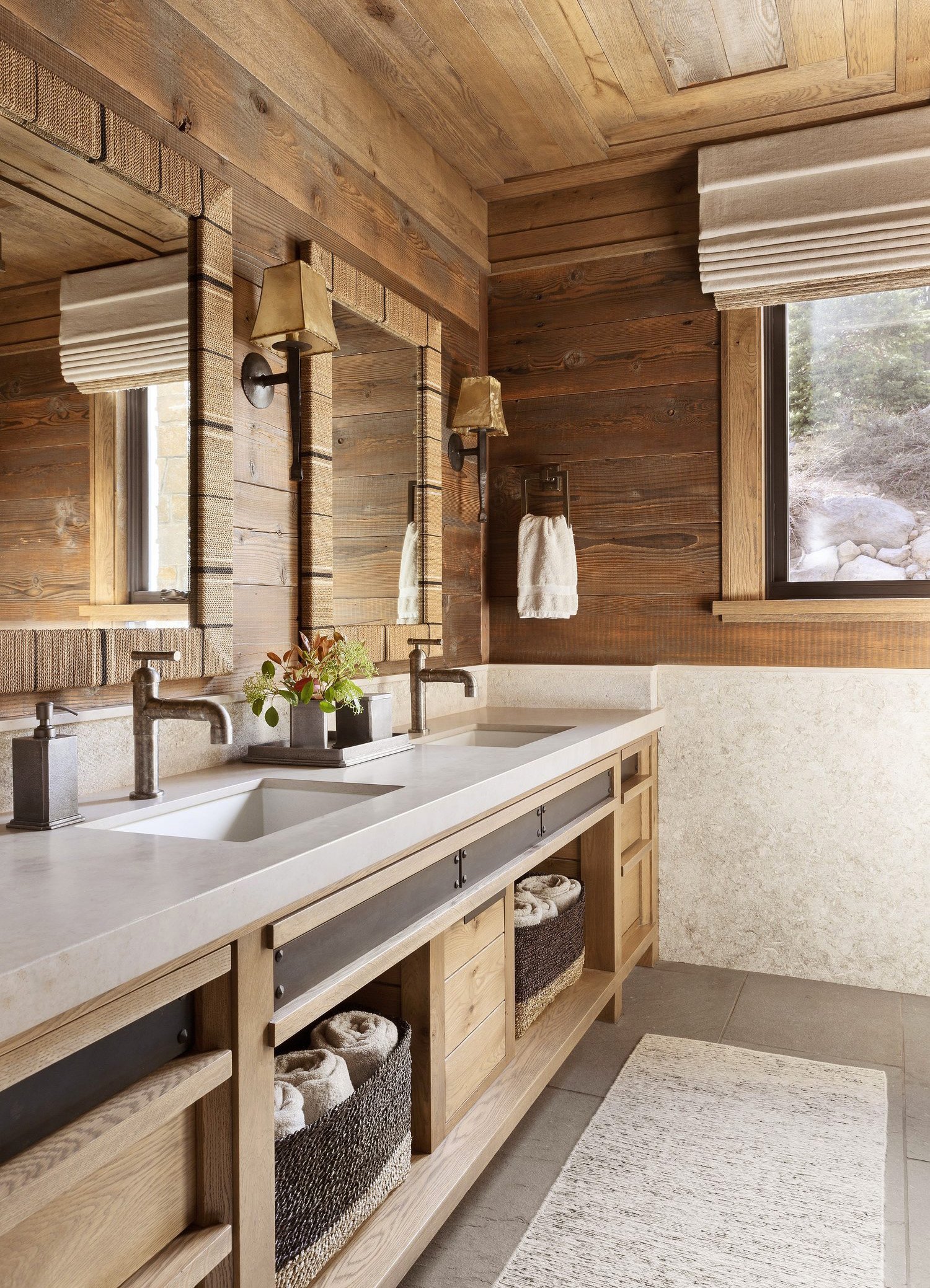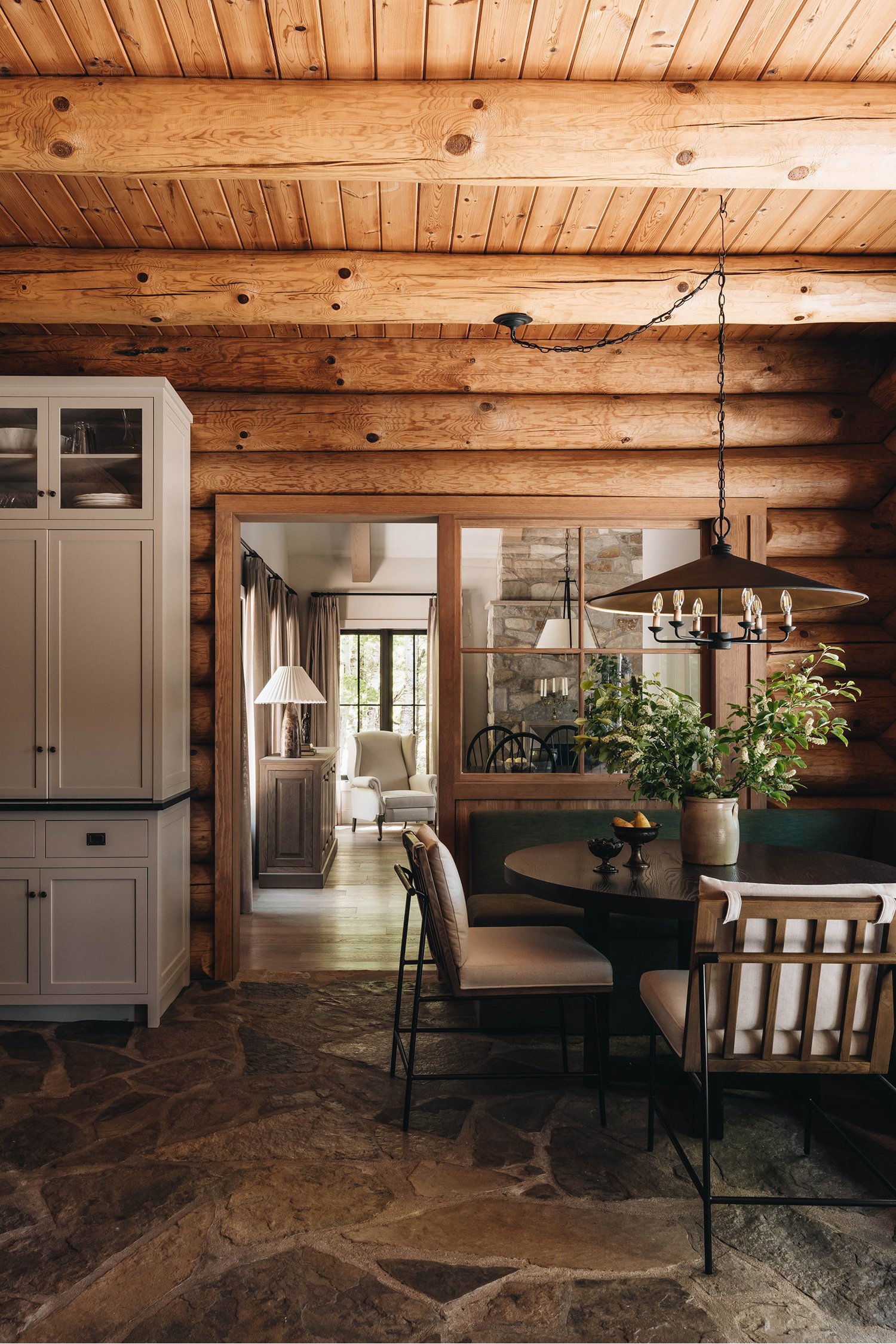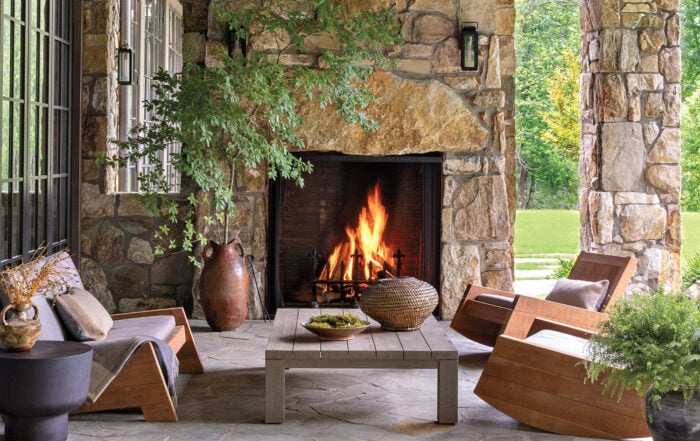What is Rustic Design Style?
By Interior Designer TRACY SVENSDEN | Published on April 15, 2019 | Updated on December 20, 2024 |
Are you yearning for a cozy, inviting living space with charm and warmth? Look no further than the rustic design style. Embracing the rustic aesthetic allows you to bring the beauty of the outdoors inside, creating a sanctuary that is both timeless and comforting.
What is rustic design style? Defined, rustic style strongly emphasizes bringing the outdoors in, embracing rugged and natural furniture and textures. It’s a difficult question to answer as it is an all-encompassing term for many similar design styles.
‘Rustic Style‘ describes everything from farmhouse and western to industrial, Southwestern, and modern-rustic design. Although the term is rather broad, several elements tie together the many forms of rustic design.
Whether in a countryside cottage or a modern urban apartment, incorporating rustic elements into your living space can effortlessly transform it into a cozy retreat. This guide will explore the key principles of the rustic design style and provide practical tips on infusing your home with rustic charm. From choosing the right color palette to selecting the perfect furniture and decorative accents, we’ll help you create a space that embraces rustic allure while reflecting your style. Feature image courtesy of Jake Arnold Design.

Rustic Living Room
Image courtesy of Shelter Interiors
1. Understanding the Rustic Design Style
The rustic design style is rooted in simplicity, nature, and a sense of history. It embraces natural imperfections and raw beauty, creating warm and inviting interiors. The key to achieving a rustic look is to balance comfort and elegance, incorporating natural elements that evoke a connection to the outdoors.

Rustic Great Room
Image courtesy of Kara Childress
2. The History and Origins of Rustic Design
The rustic design style has its roots in traditional country homes, farmhouses, and cabins. It originated from the need for practical and functional interiors built to withstand the harsh conditions of rural life.
Early settlers used natural materials such as wood, stone, and clay to construct their homes, which became defining features of the rustic style. Over time, rustic design evolved to incorporate elements of other styles, such as shabby chic and cottagecore, while retaining its principles of simplicity and nature-inspired charm.

Outdoor Rustic Seating Area
Image courtesy of Hamilton Design Associates
3. Key Elements of Rustic Design
Natural materials such as wood, stone, and metal are essential for achieving a rustic aesthetic. Exposed beams, natural stone walls, reclaimed wood floors, earthy colors, raw materials, rough textures, and stone fireplaces are all characteristic elements that add rustic charm.
Textures like burlap, linen, and wool can enhance a rustic interior’s cozy and inviting aesthetic. Emphasizing the beauty of imperfections, like distressed finishes and weathered surfaces, is another hallmark of rustic design.

Rustic Great Room
Image courtesy of Michael Smith Design
4. Rough-Hewn Beams
Rough-hewn beams instantly add rustic charm. They work to help define a space architecturally as well as anchor a rustic design. To achieve this look, use wood beams to frame ceilings, delineate doorways, and surround fireplaces and windows. Round logs lend cabin charm.
These beams are made from reclaimed or salvaged wood, making them environmentally friendly. Additionally, rough-hewn beams are incredibly strong and durable, which means they can withstand the test of time. Whether you want to create a cozy cabin feel or add visual interest to a modern space, rough-hewn beams are an excellent choice.

Key Elements of Rustic Design
Image courtesy of Kerry Joyce Design
5. Organic Forms
Using natural materials is one of the defining characteristics of a rustic home. “Rustic design, at its core, is the use of organic elements in their most natural state,” says acclaimed interior designer Katie Hodges.
Organic elements in the home help create a calm and peaceful environment. Choose materials that resonate with your style to help you connect to your interior.
These items tie us to the great outdoors, whether natural rock, wood, cotton, leather, or seagrass. Choose furnishings and decor with strong and slightly rough profiles, such as woven baskets, leafy tree branches, stump tables, and large-scale leather furniture.


Rustic Done Well
Image courtesy of Jake Arnold Design
6. Weathered Materials
Wood is a primary element used in designing and decorating rustic homes. Wood surfaces should show a bit of age. Reclaimed wood, hammered and distressed metals, and seeded glass convey a sense of history. Reclaimed wood is also ideal, providing an earthy and natural look.
Wide plank flooring compliments wood beams typically used to support ceilings. Pine, cherry, alder, and hickory are excellent for emulating a rustic feel.


What is Rustic Design Style? Weathered Materials & Warm Rich Colors
Image courtesy of Jeffrey Dungan
7. Earthtone Colors
When choosing a color palette for a rustic interior, earth tones, and warm neutrals are the way to go. Think of shades of brown, beige, cream, and gray. These colors create a soothing backdrop that complements the natural materials used in rustic design. To add depth and interest, you can incorporate pops of color inspired by nature, such as deep greens or warm oranges.
In terms of materials, wood is the show’s star in rustic design. Opt for reclaimed or distressed wood furniture to add character and a sense of history to your space. Stone and brick can be used for accent walls or fireplace surrounds to create a rustic focal point. Metal accents, such as wrought iron or copper, can add a touch of rustic elegance.
When it comes to rustic design, earth-tone colors are a popular choice for a few reasons:
- They provide a natural and organic feel to a space, which is key for creating a rustic ambiance.
- Earth tones are more muted and subdued, which helps to create a calming and relaxing atmosphere.
- These colors work well with various textures and materials often associated with rustic design, such as wood, stone, and natural fibers.


Warm Rustic Earth Tones
Image courtesy of Jake Arnold Design
8. Repurposed Objects
Rustic style is all about making do with what you already have. Found objects are key, such as wire baskets transformed into light fixtures and wood crates reimagined to hold everything from books to blankets.
Rustic interiors lend themselves to cross-pollination with industrial style. Feel free to incorporate offbeat lighting, artwork, and decorative displays.

Rustic Seating Area
Image courtesy of Pfeffer Torode Architects
9. Textural Fabrics
Sturdy fabrics with plenty of added texture are on point in a rustic home. From burlap to cotton, linen, and wool, create a warm, inviting, and cozy home. Quilts are a natural partner for rustic-style interiors, whether draped over the edge of a sofa or at the end of a bed.
Fabrics should evoke a natural aesthetic. A hand-woven rug, wicker baskets, or faux animal throw adds an effortless rustic style. As most surfaces are simple and unrefined in this design, add patterns like buffalo check, plaid, kilim, and patchwork. These patterns match the surrounding weathered elements.

Log Cabin Decorating Ideas for the Living Room | Jackson Wyoming Design
Image courtesy of Architectural Digest
10. Rustic Design for Different Rooms in Your Home
The rustic design style can be applied to every room in your home, from the living room to the bedroom and even the kitchen. When the style, colors, and materials are consistent, it helps to unify the space, making it feel more balanced and intentional.

Majestic Living Room with Rustic Furniture
Image courtesy of Brown Design Group
11. Rustic Living Room Ideas
Create a cozy seating area in the living room by choosing comfortable sofas and armchairs upholstered in natural fabrics like linen or leather. Add a rustic coffee table made from reclaimed wood and accessorize it with vintage-inspired decor like antique lamps or distressed picture frames.

Rustic Living Room
Image courtesy of Pfeffer Torode Architects
12. Rustic Bedroom Ideas
Opt for a wooden bed frame or a wrought iron canopy bed in a rustic bedroom to create a focal point. Dress the bed with soft, natural-colored bedding and layer with textured throws and cushions. Incorporate rustic lighting fixtures, such as a chandelier made from driftwood or a bedside lamp with a burlap shade.

Rustic Bedroom Design
Image courtesy of Miller Roodelle Architects
13. Rustic Kitchen Ideas
In the kitchen, embrace the rustic charm with open shelving made from reclaimed wood to display your vintage dishes and glassware collection. Choose a farmhouse-style sink and incorporate natural materials like stone or wood for countertops and backsplashes. Complete the look with rustic pendant lights and a wooden dining table surrounded by mismatched chairs.

Rustic Kitchen
Image courtesy of Blanc Marine
14. Rustic Bathroom Ideas
Consider using natural wood, stone, and metal in your rustic bathroom design. These materials can create a warm and cozy atmosphere that is perfect for a rustic bathroom.
You can add vintage or antique pieces to the space, such as an old-fashioned vanity or a clawfoot bathtub. Another great way to decorate a rustic bathroom is to incorporate nature-inspired elements, such as plants, flowers, and natural textures like woven baskets or jute rugs.
Combine these elements with soft lighting and neutral colors to create a calming and inviting space. For a finishing touch, incorporate rustic bath towels and accessories in earth tones.

Rustic-Style Bathroom
Image courtesy of Brown Design Group
15. Rustic Furniture and Decor Ideas
When selecting furniture for a rustic interior, focus on sturdy, durable pieces with a natural, organic feel. Wooden tables, chairs, and cabinets with a distressed or aged finish are perfect for bringing a rustic touch to your living space. Look for furniture with simple, timeless designs that will stand the test of time.
To enhance the rustic ambiance, incorporate cozy textiles like wool or faux fur throws, plaid or floral patterned cushions, and natural fiber rugs. These elements add warmth and texture while staying true to the rustic aesthetic. Consider hanging vintage or handmade quilts on walls as unique and charming decor.


Rustic Decorating Ideas
Image courtesy of Kara Childress
16. Be Surprising
Introduce sleek, modern materials like glass or metal alongside traditional wood and stone. For example, a glass coffee table can provide a contemporary touch while allowing the rustic elements in the room to shine.
“Look for opportunities to increase your connection with nature and the outdoors through larger windows, glass doors, skylights, and the like. In selecting materials, reference nature in contemporary but unexpected ways. Rubbed steel and open-grained woods are ideal, done with subtlety and refinement.” ~ Fawn Galli of Fawn Galli Interiors

Rustic Room Filled with Natural Sunlight
Image courtesy of Jenn Feldman Design
17. Go Natural
Using natural materials adds authenticity to the design. Rustic spaces often showcase imperfections and raw beauty, celebrating the unique characteristics of each material. This authenticity creates a sense of history and depth in a home.
“The goal here is to maintain the natural elements in conjunction with symmetry and clean lines. Materials like wood and stone should reflect natural elements. Put a more rustic frame on modern art or mirror, and add round and softer features to balance them out. Opt for wood flooring with a fabulous contemporary rug atop—over-dyed, Moroccan, cowhides, etcetera.” ~Santa Monica-based designer Kimba Hills.

Rustic Dining Room
Image courtesy of Amber Interiors
18. Create Contrasts
Creating contrasts in rustic design is essential for adding depth, interest, and balance to the overall aesthetic. Contrasting elements, such as combining rough textures with smoother finishes, can draw the eye and create a more dynamic space.
“In a clean setting, rustic elements gain more attention and often take a more artistic and sophisticated feel than in a completely rustic interior. For me, chandeliers are significant. I love, for example, using rustic elements to create chandeliers; they gain a very dynamic feel when paired with elements that illuminate them.” ~Phillip Thomas, founder and principal of Phillip Thomas, Inc. in New York City

Modern Rustic Living Room
Image courtesy of Brown Design Group.
19. Combine Styles
Mixing styles adds layers and depth to a room, making it feel more lived-in and personalized. Rustic design often draws from traditional styles, so merging elements like industrial, vintage, or farmhouse can give a timeless quality to the space while still feeling fresh and modern.
“You can create a rustic vibe in a modern room by using wood elements, such as reclaimed wood beams and stone, keeping all finishes natural and selecting a palette that complements the natural materials. Juxtapose natural finishes with clean architectural details—wide-plank rift oak wood floors in a satin finish with white walls.
Materials such as wood-paneled walls, field stones, black iron, brick, or a blackened wood finish (there’s a charring process that gives the wood age and character with a modern aesthetic) on either a paneled ceiling or walls create an unexpected punch. Some of our favorite types of furniture for this look are live-edge dining tables and petrified wood pieces with textured fabric on upholstery.” ~ Cristina Peffer of Babcock Peffer Interior design firm in Southhampton, New York

Southwestern Living Room
Image courtesy of Modern Nest
20. Tips for Incorporating Rustic Design into Small Spaces
You can still achieve a rustic look in your small living space, even with limited square footage. The key is to maximize the use of natural light and choose furniture and decor that are proportionate to the size of the room. Opt for light-colored walls and floors to create an illusion of space and openness.
Avoid clutter and choose multifunctional furniture that serves a dual purpose, such as a storage ottoman or a coffee table with built-in shelves. Incorporate mirrors to create the illusion of depth and reflect natural light.

Rustic Design in Small Spaces
Image courtesy of Brittany Hakimfar Design
21. Rustic Design on a Budget
Achieving a rustic look doesn’t have to break the bank. You can create a rustic interior on a budget with a bit of creativity and resourcefulness. Here are some tips:
- Shop for second-hand furniture and decor at thrift stores, flea markets, or online marketplaces.
- Repurpose old wooden crates o pallets to create rustic storage solutions like shelves or coffee tables.
- Use natural elements like pine cones, branches, or dried flowers as free and beautiful decor.

What is Rustic Design Style?
Image courtesy of Blanc Marine
Conclusion: Embracing the Rustic Style in Your Living Space
Incorporating the rustic design style into your living space allows you to create a warm, inviting, timeless, and comforting atmosphere. You can transform your home into a haven of natural beauty by understanding the key principles of rustic design and incorporating organic materials, earthy tones, wooden beams, and rustic furniture and decor. Whether you live in a countryside cottage or a modern urban apartment, embracing the rustic aesthetic will bring the beauty of the outdoors inside and create a space that reflects your style.
Share This Story, Choose Your Platform!
View Recent Posts
Beautiful Outdoor Living Spaces
Discover the art of creating a resort feel in your backyard and elevating your front porch into the perfect place to unwind and relax. Here, you'll find ideas on how to make your outdoor space as beautiful as your indoor ones, regardless of the size of the project.
3 Stunning Mountain Home Interiors
The invigorating mountain air, stunning vistas, and a focus on outdoor living are undeniably appealing aspects of mountain home life. Take a tour of 3 beautifully designed modern mountain homes that resonate with their natural surroundings.
Mountain Chic Design Home Tour
Take a tour of a gorgeous modern mountain chic home located in North Carolina. This magnificent home celebrates the natural beauty of its surroundings - hiking trails, serene ponds, and scenic mountain views.
Rustic Outdoor Design Ideas
Creating a rustic outdoor living area can be a great way to extend your home and enjoy the beauty of nature.
Home Decorating Tips
This curated guide covers reimagining your space and creating an inviting, layered home that transcends time. Here, I'll lay out the secrets of top interior designers, focusing on intentional style that feels lived-in and endlessly classic.
Rustic Kitchen Ideas
Looking to add a touch of rustic charm to your kitchen? Look no further! This article will explore inspiring ideas that will help you transform your kitchen into a cozy, rustic retreat.








Leave A Comment
You must be logged in to post a comment.